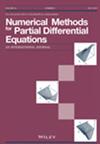应用于斯托克斯问题的增强非连续伽勒金方法的后验误差分析
IF 1.7
3区 数学
Q1 MATHEMATICS, APPLIED
引用次数: 0
摘要
本文涉及静止斯托克斯问题的增强混合非连续公式的后验误差分析。通过考虑一个适当的辅助问题,我们得出了一个后验误差估计器。我们证明了这个估计器是可靠和局部有效的,并且只包含五个残差项。数值实验证实了增强非连续方案和估计器的理论特性。实验还表明,相应的自适应算法有能力定位解的奇点和大应力区域。本文章由计算机程序翻译,如有差异,请以英文原文为准。
An a posteriori error analysis for an augmented discontinuous Galerkin method applied to Stokes problem
This paper deals with the a posteriori error analysis for an augmented mixed discontinuous formulation for the stationary Stokes problem. By considering an appropriate auxiliary problem, we derive an a posteriori error estimator. We prove that this estimator is reliable and locally efficient, and consists of just five residual terms. Numerical experiments confirm the theoretical properties of the augmented discontinuous scheme as well as of the estimator. They also show the capability of the corresponding adaptive algorithm to localize the singularities and the large stress regions of the solution.
求助全文
通过发布文献求助,成功后即可免费获取论文全文。
去求助
来源期刊
CiteScore
7.20
自引率
2.60%
发文量
81
审稿时长
9 months
期刊介绍:
An international journal that aims to cover research into the development and analysis of new methods for the numerical solution of partial differential equations, it is intended that it be readily readable by and directed to a broad spectrum of researchers into numerical methods for partial differential equations throughout science and engineering. The numerical methods and techniques themselves are emphasized rather than the specific applications. The Journal seeks to be interdisciplinary, while retaining the common thread of applied numerical analysis.

 求助内容:
求助内容: 应助结果提醒方式:
应助结果提醒方式:


